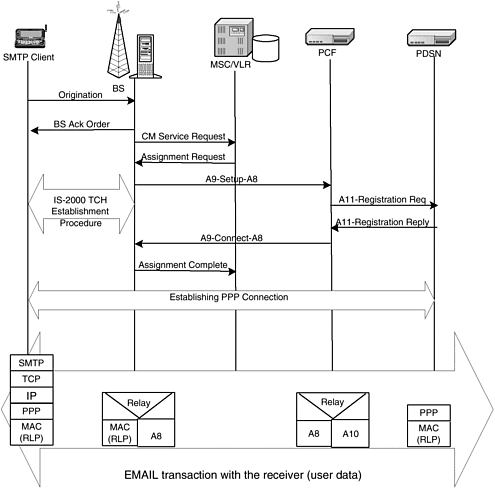10.6 IP Application
| Let's look at a complete picture of an IP application running over the network. The overall message flow is split up into two figures for clarity. Figure 10-9 illustrates the message flow with RN as a black box. Figure 10-10 gives the inside view of RN and shows the message flow between the different components of RN. Figure 10-9. MS-initiated e-mail transaction. Figure 10-10. MS-initiated e-mail transaction ”RN view. It is assumed that an MS is sending an e-mail message using SMTP. When the MS executes command to send an e-mail message, it invokes the underlying TCP layer. The TCP invocation causes the cdma2000 layer 3 functions to send an origination message with the data service option to the BSC. The message is sent over the access channel of the air interface with layer 2 acknowledgment required. The BSC acknowledges the receipt of the message with a BSC acknowledgment order message. The BSC constructs the CM service request message, sends the message to the MSC, and starts timer T303. The MSC, after recognizing that the request is for data service, sends an assignment request message, without allocating any terrestrial circuit to the BSC, to request assignment of radio resources and starts timer T10. The BSC and the MS initiate the establishment for a radio traffic channel. Now that the CC connection through the BSC and MSC is completed, the BSC initiates the data session connection through the PCF and PDSN. For this, the BSC sends an A9-setup-A8 message to the PCF to establish an A8 connection and starts timer TA8 setup. The PCF recognizes that no A10/A11 connection associated with the MS is available and selects a PDSN for the call. The PCF sends an A11 registration request message to the selected PDSN and starts timer T-regreq. The PDSN validates the A11 registration request message and accepts the connection by returning an A11 registration reply message with an accept indication and the lifetime set to a preconfigured value. The A10/A11 connection, once established, will be periodically refreshed after every expiry of the lifetime timer. Upon establishment of the A10/A11 connection, the PCF completes A8 connection by transmitting an A9-connect-A8 message to the BSC. The BSC sends an assignment complete message to the MSC, thus completing CC connection through the MSC. In this way a bearer path is established to transport user plane data between the MS and the PDSN through the PCF/BSC. The PPP connection establishment procedure is initiated at this point. The network may ask for the CHAP/PAP user authentication as part of this procedure, which involves AAA agents for the verification of the authentication information. The PDSN sends an agent advertisement to the MS over the PPP link. The MS sends a registration request to the PDSN along with its CoA. The PDSN forwards the registration request to the HA. The HA verifies the mandatory MS-HA authentication extension and sends the registration reply back to the MS through the PDSN. The other security associations (refer to Section 10.2.2) may also be verified as part of registration. At this point all the necessary signaling has been performed and the HA knows where it needs to send data for the MS. In the user plane path the IP packets sent by the e-mail application in the MS take different forms. The PPP layer encapsulates the IP packets into PPP frames. The RLP layer converts the PPP frames into radio frames. The radio frames go through the multiplex sublayer, which converts them into physical layer SDUs. On the network side the reverse operation takes place in the BSS and PDSN. The PCF tunnels the PPP frames using GRE tunnel to the PDSN. The PDSN recovers the IP packets from the PPP frames and sends them over the reverse tunnels to the HA. The HA forwards them to the SMTP server. |
EAN: 2147483647
Pages: 164

